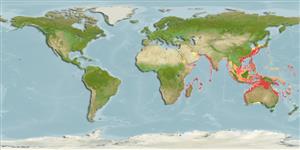Environment: milieu / climate zone / depth range / distribution range
Ecology
Marine; reef-associated; depth range 1 - 150 m (Ref. 9710). Subtropical; 36°N - 36°S, 23°E - 175°E (Ref. 5222)
Indo-West Pacific: East Africa to the western Pacific, southward into temperate waters of South Africa, Australia, and New Zealand. Not known from the Red Sea or Persian Gulf.
Length at first maturity / Size / Weight / Age
Maturity: Lm 19.4, range 14 - ? cm
Max length : 45.0 cm TL male/unsexed; (Ref. 90102); max. published weight: 1.4 kg (Ref. 5222)
Dorsal
spines
(total): 11;
Dorsal
soft rays
(total): 16-18;
Anal
spines: 3;
Anal
soft rays: 8. Characterized by red-brown head; body mottled pale-brown color; 5-6 irregular dark brown bars on body; caudal fin dark brown with pale speckling; body scales ctenoid except cycloid anterodorsally above lateral line, on nape, thorax and abdomen; body with auxiliary scales only anterodorsally behind zone of small cycloid scales; greatest depth of body; 2.7-3.2 in SL; rounded caudal fin; pelvic fins, 1.9-2.4 in head length (Ref. 90102); body depth contained 2.7-3.2 times in SL; head length 2.3-2.6 times in SL; head length 2.3-2.6 times in SL; flat to slightly convex interorbital area, dorsal head profile convex; snout length 4.0-5.0 in HL; angular preopercle, with enlarged serrae at angle; straight upper edge of operculum, almost horizontal; posterior and anterior nostril subequal in size; maxilla reaches to or past vertical at rear edge of eye, ventral edge with slight step at distal expansion; 2-3 rows of teeth on midlateral part of lower jaw; pyloric caeca (Ref. 89707).
Sedentary reef-associated species (Ref. 89707). Occurs on coral reefs, areas with rocky substrata, algal flats and seagrass beds. Feeds on fishes and crustaceans (Ref. 30573). A protogynous hermaphrodite (Ref. 55367). Forms spawning aggregations (Ref. 55367). Solitary (Ref 90102).
Life cycle and mating behavior
Maturity | Reproduction | Spawning | Eggs | Fecundity | Larvae
A monandric species (Ref. 55367). Length at sex change = 75.6 cm TL (Ref. 55367).
Heemstra, P.C. and J.E. Randall, 1993. FAO Species Catalogue. Vol. 16. Groupers of the world (family Serranidae, subfamily Epinephelinae). An annotated and illustrated catalogue of the grouper, rockcod, hind, coral grouper and lyretail species known to date. Rome: FAO. FAO Fish. Synop. 125(16):382 p. (Ref. 5222)
IUCN Red List Status (Ref. 130435)
Threat to humans
Harmless
Human uses
Fisheries: minor commercial
More information
ReferencesAquacultureAquaculture profileStrainsGeneticsElectrophoresesHeritabilityDiseasesProcessingNutrientsMass conversion
Tools
Special reports
Download XML
Internet sources
Estimates based on models
Preferred temperature (Ref.
123201): 21.5 - 28.8, mean 27.2 °C (based on 1542 cells).
Phylogenetic diversity index (Ref.
82804): PD
50 = 0.5000 [Uniqueness, from 0.5 = low to 2.0 = high].
Bayesian length-weight: a=0.01259 (0.00794 - 0.01995), b=3.03 (2.90 - 3.16), in cm total length, based on LWR estimates for this species & Genus-body shape (Ref.
93245).
Trophic level (Ref.
69278): 3.6 ±0.54 se; based on food items.
Generation time: 2.9 ( na - na) years. Estimated as median ln(3)/K based on 2
growth studies.
Resilience (Ref.
120179): High, minimum population doubling time less than 15 months (K=0.4).
Fishing Vulnerability (Ref.
59153): Low to moderate vulnerability (32 of 100).
Nutrients (Ref.
124155): Calcium = 22.1 [7.7, 45.5] mg/100g; Iron = 0.54 [0.27, 1.15] mg/100g; Protein = 19.1 [17.6, 20.6] %; Omega3 = 0.208 [0.115, 0.369] g/100g; Selenium = 19.8 [9.8, 39.7] μg/100g; VitaminA = 97.4 [23.4, 395.0] μg/100g; Zinc = 0.901 [0.594, 1.361] mg/100g (wet weight);
